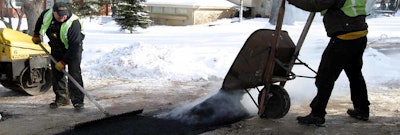
“Can asphalt pavement be put down during colder weather?” It is a simple question, but the answer is complicated. Asphalt contractors have to evaluate more than just the temperature registering on the thermometer hanging outside the office to decide whether it is too cold to pave.
During colder temperatures, mix temperature is critical to achieving compaction. You will have less time to compact the mix in cold weather, as the mix will cool more quickly. Contractors need to understand the factors that affect the cooling rate of the mix. Before paving, decide what variables you are willing and able to control, such as project size and requested mix delivery temperature.
Keep these five things in mind before paving in cooler weather.
- Ground Temperature:
What is the temperature of the foundation for the pavement? In many cases, the ground temperature, or the temperature of the foundation that will be supporting the pavement, is the most critical factor. Normally, contractors will not apply pavement when the ground temperature is below a certain point. The colder the foundation, the quicker the asphalt will lose its heat, making it difficult — if not impossible — to achieve adequate compaction.
The time available for compaction (TAC) defines the total amount of time that rollers operators have to compact the mix before it loses too much heat and becomes too stiff to compact.
- Lift Thickness:
How thick is the pavement to be? The thinner the layer of asphalt, the faster heat will dissipate. This means that in cold weather, crews have a very small window for working a thin layer.
Thicker lifts hold temperature much longer than thinner lifts. The heat retained in asphalt lifts is not a linear relationship, but rather an exponential one. For example, 3-in. lift will retain heat for approximately four times as long as a 1.5-in. lift of the same mix placed under the same conditions.
- Mix Delivery Temperature:
How far is the asphalt plant from the jobsite? Asphalt is hot when it leaves the plant, and if it cools in transit, it can be unusable upon arrival. Crusts on top of the asphalt or segregation of components would result in pavement of inferior quality with a reduced life expectancy. There are transport methods that can help protect asphalt during transfer, but over long distances, these methods may be insufficient.
- Ambient Air Temperature:
This has a relatively minor influence on the cooling rate of HMA. However, if the ambient air temperature is combined with wind, a condition of both conductive and convective heat transfer occurs. Heat is now being lost to the base through conduction and to the air through convection. The greater the wind speed, the more quickly it will remove heat from the HMA.
Above all else, the temperature of HMA during the rolling operation is what will determine how successful the compaction operation will be. It’s important to have an understanding of how mix temperature is related to the compaction of HMA.
- Solar Radiant Flux:
This refers to the effect of the sun on HMA temperatures. The net heat loss from the pavement that is the difference between the heat absorbed by the pavement from the sun’s rays and the heat that radiates off the mat into the air.
Simply stated, this means that sunshine will help reduce the rate of cooling of the placed HMA. When placing HMA, ensure that the mix temperature is a minimum of 290° F at the mid-depth of the mat behind the screed when the compaction process begins.















![Lee Boy Facility 2025 17 Use[16]](https://img.forconstructionpros.com/mindful/acbm/workspaces/default/uploads/2025/09/leeboy-facility-2025-17-use16.AbONDzEzbV.jpg?ar=16%3A9&auto=format%2Ccompress&fit=crop&h=135&q=70&w=240)




